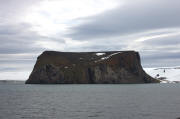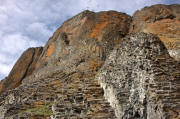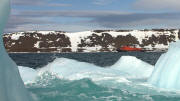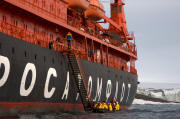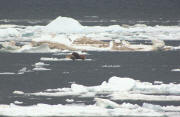John Gareri
Welcome to my Website
Franz Josef Land
| July 14-15. After visiting the North Pole we visited the islands of Franz Josef Land for a couple of days before continuing south to Murmansk. Highlights of these two days for those that don't want to read much:
rocks birds zodiacs icebergs abandoned Soviet Research Stations Walrus 14 July – Today was a true expedition day, as we explored Franz Josef Land by ship, by zodiac and by foot. We had traveled overnight from the pack ice around Jackson Island in the north part of the archipelago to Hooker Island in the southern waters of the British Channel. On the northwestern side of Hooker Island is a protected inlet called Calm Bay or Bukta Tikhaya in Russian. There is an abandoned meteorological station, a large glacier face, flat-topped hills covered by a blanket of white snow and a massive basalt outcrop called Rubini Rock, home to a staggering display of nesting seabirds. Thousands of years ago, liquid magma poured over this land and as it cooled it formed basaltic hexagonal columns, which erode leaving little ledges as the upper part of the column breaks off. The Brunnich’s guillemots occupied the lower levels of these cliff edges, with the kittiwakes one level up followed by the little auks. Other birds such as glaucous gulls and black guillemots slotted in as well, making this a very diverse and very boisterous community. The water in front of this cliff is quite deep, therefore the crew was able to gently place our bow a mere meters away from this cacophony. Next was a zodiac cruise of this delightful bay. We set off in groups of ten to twelve, each with an expedition team driver who explained the history, geology and biology of the area which we were viewing. We cruised under the bird cliffs of Rubini Rock to see at close range the wonderful activity of the kittiwakes and guillemots, reminded not to look up with mouths open. A few lucky people were anointed by our flying friends as they went out to sea in search of food. The pure remoteness and serenity of this place sank in as we regarded the tundra slopes, icebergs and glacier fronts from our zodiacs. With time for lunch and a hot drink to warm up, we were ready for the afternoon excursion to the |
old Soviet meteorological and geological research facility called Sedov Station. Named after
Georgi Sedov, a Russian explorer who set out from this point to try for the pole in 1914, the
remains of this base are incredibly well intact. The base was built in 1929 and abandoned in
1963 and has been in a slow state of decline ever since, with only a few buildings still kept up for
occasional scientific research. The area consists of several bunk houses and storage cabins, as
well as a meteorological lab, a windmill generator, dog kennels, domestic animal pens and an
aircraft hanger. Airplanes designed to land on both water and ice were used to conduct an aerial
mapping survey of the islands. Above the base on the craggy slopes, there was a colony of little
auks, calling constantly and flying in large groups in no particular direction like a winged school
of fish. The route to this colony was tricky though as you needed to cross a large wet bog of
moss and mud. A few people even opted for a mud bath, inadvertently sinking into the deep
squish all the way up to their midsections. 15 July – The officers and crew of 50 Years of Victory repositioned the ship overnight, taking us through Markham Strait and the Austria Channel northeast to Wilczek Land. Our proposed landing site was Cape Heller (or Fort McKinley) on the northwest side of the island. Just before breakfast, our first walrus came into view, huddled on the floating ice in the channel. These blubbery beasts are an arctic icon, and we were all overjoyed to see our first glimpses of them. Walrus are often found in groups, using each others body heat to stay warm and conserve energy for digestion of the mollusks which make up their main diet. They have no need to crack the shells of these mollusks, sucking the flesh out of the shell with their powerful vacuum-like mouths. Both males and females have tusks, making them hard to distinguish from a distance. This particular group seemed to be huddled protectively around their young calves, with one in the water bobbing up and down like a sentry trying to get a better view of us. Unfortunately, the weather played its hand this morning and we were unable complete our planned excursion to Cape Heller. The wind was blowing at over 20 knots and the ice on the shoreline prevented any landing area from being accessible. This would be the theme for the rest of the day. It was not possible to do any more landings as the wind just continued to increase. |
Below is a slideshow of all my pictures from Franz Josef Land.
